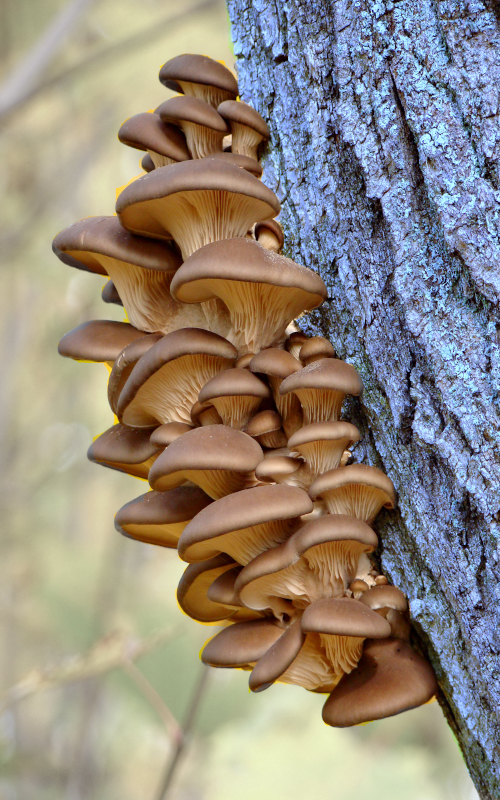Brìgh fiodha
"I understand, Diamynedd, how important these are to you, but this winter was pretty dry in Cymru...""And I would succumb ten crates, but one?! What am I suppose to tell the skalds, hmm?""Tell them the truth — that most of the Brìgh fiodha were already taken for the Festival."
Summary
Brìgh fiodha belong to the group of parasitic mushrooms, typically spotted in the region of Cymru around winter time. They, along with Velvet shanks form the basis of the Winter Stew prepared for making people warm during the Festival of Ædean Paths. Their main usage is centered around the wood concept, concentrated in the fruiting bodies and most abundant in the fully matured ones. Just like Velvet shanks serve as the source of the fire concept, the Brìgh fiodha provide the fuel so that the fire could burn for the whole night.
Description

Cap
Shell-shaped to curled tongue-shaped and velvety smooth, with a fiber-like texture running from the stem to the edge. The coloration usually a variety of shades of pale yellow and brown, and on rare occassions with a tinge of grey. Moreover, the intensity of the pigment is strongly dependent on the environment, i.e., the type of wood the mycelium inhabits and the intensity of sunlight. Generally, the harder and denser the wood, the more intense the coloration will become. The deciding factor, however is the abundance of sunlight, which serves as a developing agent. Some Brìgh fiodha, especially those found on darach trees in darker or strongly shaded regions, will seem greyish with a yellowish tinge.
Gills
Pale cream and flexible in younger fruiting bodies, turning wooden brown and stiff in older specimens.
Stem
Usually short, up to 1cm or barely noticeable. In most cases up to a few fruiting bodies grow from a single stem. Its texture is fiber-like and rubbery flexible, but over time turns more and more stiff and akin to wood. Should the fruiting body be cut off with the stem left, new ones will grow back provided sufficiently freezing weather and sunlight.
Odour
Pleasant and mellow in younger fruiting bodies. Older specimens concentrate the concept of the wood they feed upon, which adds specific undertones, e.g., darach will be on the sweet side, while spruce will add citrus-like freshness. The mellow odour becomes faint to non-existent in fully matured fruiting bodies.
Taste
Mellow in younger fruiting bodies, fading over time and giving away to bitterness.
Similar species
A certain species of sea mushroom found on the Brudhe coastline have been used by the merchants to fake the Brìgh fiodha. While some of their properties are similar, e.g., the ability to concentrate the wood concept in fruiting bodies, additional concepts have been found that make their use for Winter Stew cumbersome and with poor results. Thus, although they are rarely seen in the Cymru region, very often in times of low supply, they have been sold to the more distant Gáláwá region as fully matured fruiting bodies of the Brìgh fiodha.
Growth cycle
What is death without life — mycorrhiza
Brìgh fiodha start their life cycle along with the seed of a tree they will inhabit. In the beginning the mycelium helps the growing plant gather water, minerals and protect it from potential harm of the environment. During that process, the mycelium grows both deep within the core and to limited extent even on the surface of the plant. Identification of the wood affected with the mycelium is difficult and to naked eye almost impossible. More sensitive skalds, though, can identify the connections to the concepts of betrayal and illness, which will clash with the usually good quality of the wood.
False youth — time seems to slow down
When the tree grows big enough, usually no sooner than after 20-50 years, the mycelium enters the second stage, commonly refered to as the youth years or false youth. The term was coined to honour the state in which the tree technically becomes older, but to the observer remains the same, even for several years. During that time, Brìgh fiodha starts feeding both on the physical wood and on the wood concept of the host. The mycelium slowly fills the place of the wood, becoming thicker and harder. Such wood is refered to as meòganach and can be used for its unique pattern, provided the falsity concept is removed from it for safety reasons. Should that step be omitted, the person close to the meòganach item may follow the pattern of @con and embed it in their mind. In such case the end result will vary from person to person, with the person either passively attracting falsity or actively becoming a source of it.
Formation of fruiting bodies
With the mycelium fully matured, the fruiting bodies start to form soon after the first frosts. The first buds form in the weakened parts of the tree, i.e., cracks, broken parts of the bark, thin sections and the fruiting bodies grow only during the winter season. While the growth rate is higher around the melting point of ice, denser and higher quality mushrooms are collected with freezing temperatures outside. The optimum growth conditions were not yet established. So far the highest quaity fruiting bodies were collected in the mountains near the Forest of Spring. It is worth noting that at ths stage, the falsity concept loses its grip to the wood and especially after the first frosts is replaced by the concepts of care and defence. Since the matured fruiting bodies become ligneous, they act as a cover for the mycelium and its host.
Habitat
Brìgh fiodha are typically found in the colder regions of Cymru, i.e., in the mountains near the Forest of Spring, where some fruiting bodies were found growing undisturbed for many years, before reaching full maturity. Some weeks after the Autumn Equinox they can be found further and further from the mountains and around two weeks before the Festival of Ædean Paths they can be found even in the central parts of the Cymru region. Brìgh fiodha do not seem to favor any particular trees, but are found in greater amounts in copses of trees with thinner or cracked bark, e.g., calch or beithe.
Cultural use
Just as Velvet shanks provide the concept of fire, Brìgh fiodha provide the wooden fuel that fire could feed on to provide warmth. They are used as the second key ingredient of the Winter Stew and since their discovery the Cymrians have never replaced them. The mycelium extracted from an already fruiting Brìgh fiodha is used for healing purposes and sometimes is strung on a blue lotus silk to form a good luck charm. With respect to the fully matured fruiting bodies, they are often used for repairments as a concentrated source of the wood concept. On rare occassions, when conifers were the hosts, the powdered Brìgh fiodha serve as a substrate for extraction of fragrant substances, such as oils.









Their lifecycle is so intriguing and long. I can definitely see why they are characterised as a parasitic mushroom! I really hope to see an article about winter stew at some point. These mushroom articles have made me really intrigued. :D
The season for these little guys and the velvet shanks has already started, so I may be tempted to forage some and make a recipe with pictures and all. Shanks are difficult ones to find, though, so the stew may be added later. It's a lottery at this point. Thank you! <3